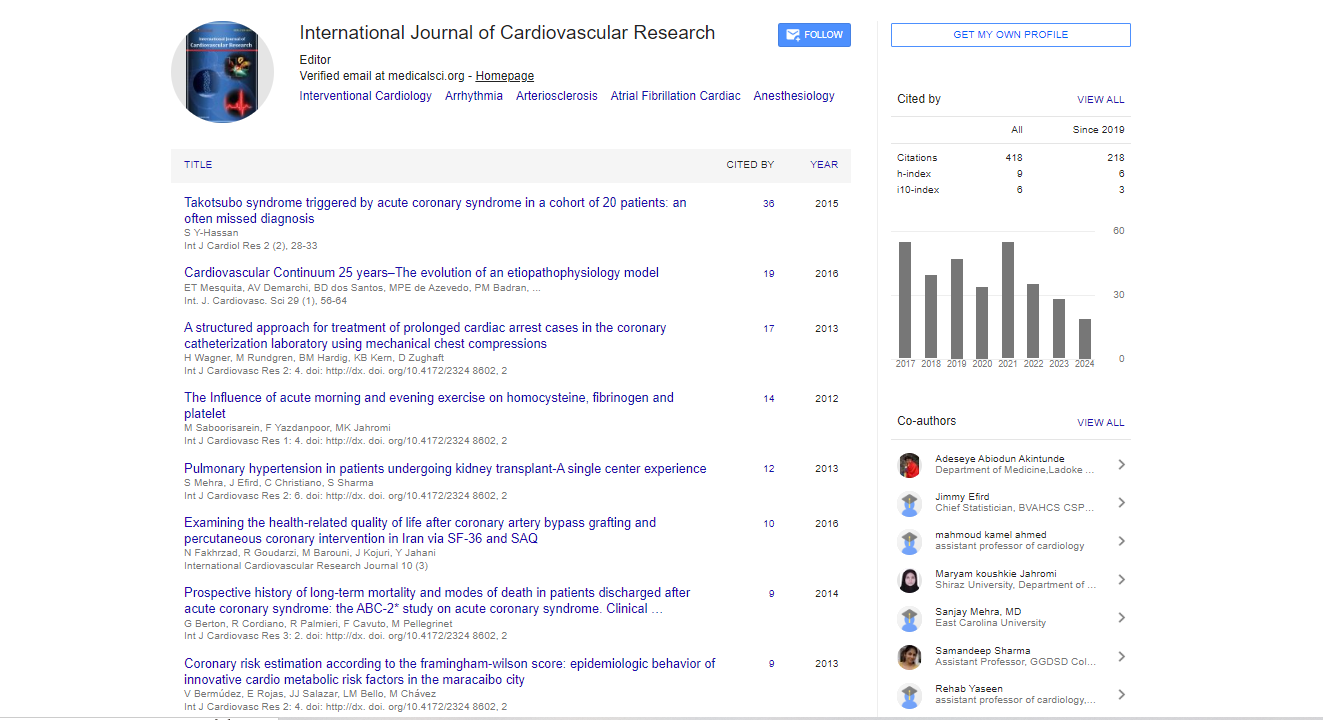Research Article, Int J Cardiovasc Res Vol: 7 Issue: 3
Longitudinal Retrospective Study with over 500 Participants Shows Main Continuous Predictors for Angioplasty: Clinical Trial
Diego Novelli1,2, Buchalla M1, Cury MBB1, Negrão RR1, Junior JB1, Fernandes HT1, Marchioni ALG2, Filho IJZ3* and Ramirez AVG4
1Santa Casa de Misericórdia Hospital, Rua Fritz Jacob 1226 São José do Rio Preto/SP, Brazil
2Di Marchioni Office, Rua José Polachini Sobrinho 480 JD. Urano São José do Rio Preto/SP, Brazil
3São Paulo State University (Unesp), Institute of Biosciences, Humanities and Exact Sciences (Ibilce), Campus São José do Rio Preto/SP, Brazil
4Brazilian Association of Nutrology (ABRAN) / Brazilian Association of Nutrology, Catanduva / SP, Rua Belo Horizonte, 909 - Centro, Catanduva SP Brazil
*Corresponding Author : Prof. Dr. Idiberto José Zotarelli Filho
São Paulo State University (Unesp), Institute of Biosciences, Humanities and Exact Sciences (Ibilce), Campus São José do Rio Preto/SP, Brazil
Tel: +55(17) 8166-6537
E-mail: m.zotarelli@gmail.com
Received: February 01, 2018 Accepted: February 20, 2018 Published: February 27, 2018
Citation: Novelli D, Buchalla M, Cury MBB, Negrão RR, Junior JB (2018) Longitudinal Retrospective Study with over 500 Participants Shows Main Continuous Predictors for Angioplasty: Clinical Trial. Int J Cardiovasc Res 7:3. doi: 10.4172/2324-8602.1000351
Abstract
Objective: Coronary artery disease results in higher morbidity, mortality, and medical costs than any other illness in the developed world. The improvement of coronary artery disease non-invasive detection is still actual problem. The aim of this study was to increase the quality of non-invasive diagnostics of coronary artery disease with statistical technology of ECG signal processing for quantitative assessment the degree of myocardial ischemia and the coronary artery lesion.
Methods and Results: The four minutes 12-channel electrocardiogram was used for the statistical technology of ECG signal processing to gain 200 PQRST complexes. It allowed calculating L criterion from relation of standard deviation to average value of 200 T-wave times and G-criterion the from relation of standard deviation to average value of 200 T-wave amplitudes in all 12 channels. The L and G criteria were compared by relation the maximum value in one channel to minimum value in another channel to get the second order L and G criteria. 139 patients with suspected coronary artery disease underwent elective coronary angiography and were examined by G and L criteria. Among patients with coronary angiography the values of second order L-criterion had a strong positive correlation with the value of coronary artery lesion (correlation factor r = +0.894). The values of G-criterion quantitatively reflect the severity of clinical presentation and confirm the functional classes.
Conclusions: The offered statistical technology of quantitative assessment of electrocardiographic curve parameters allows indirectly assessing the coronary blood flow and the degree of ischemic process regardless the presence of risk factors and clinical presentation. The localization of maximum ischemic process according the appropriate leads can help in selection of stent implantation priority.
 Spanish
Spanish  Chinese
Chinese  Russian
Russian  German
German  French
French  Japanese
Japanese  Portuguese
Portuguese  Hindi
Hindi 



